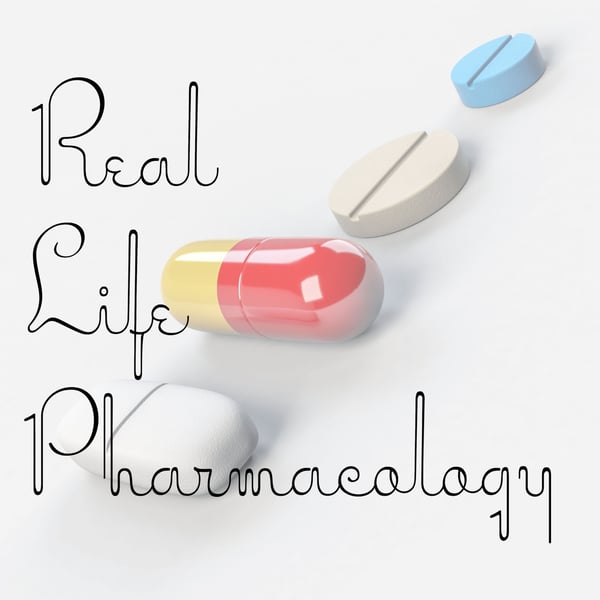Quetiapine Pharmacology
Real Life Pharmacology - Pharmacology Education for Health Care Professionals
Eric Christianson, PharmD; Pharmacology Expert and Clinical Pharmacist
5 • 716 Ratings
🗓️ 2 September 2021
⏱️ 14 minutes
🧾️ Download transcript
Summary
Quetiapine (Seroquel) is a medication seen a fair amount, particularly in the geriatric population where there is psychosis associated with dementia. It is classified as an antipsychotic. Mechanistically it's going to block dopamine receptors, specifically D2. It also has some serotonin receptor blockade antagonism. It does have other activity as well from a mechanism of action standpoint. There is alpha-blocking activity potentially as well as an antihistamine/anticholinergic type of activity. Uses of this medication are schizophrenia, bipolar disorder with associated mania, miscellaneous psychotic disorders, and Parkinson’s type disease with psychosis. Off-label you may see it used for OCD, or augmentation for PTSD and depression.
There is a boxed warning of increased risk of mortality in elderly/dementia patients. As a class, antipsychotics have extrapyramidal symptoms, metabolic syndrome, anticholinergic activity, QTC prolongation, sexual dysfunction, hyperprolactinemia, neuroleptic malignant syndrome, sedation, fall risk, and potentially a drop in blood pressure as well. With quetiapine, it is important to recognize that antipsychotics can have varying degrees of how much these adverse effects happen and a lot of them are dose-dependent.
There are three important points in comparison to other antipsychotics. Quetiapine is not that great as far as metabolic syndrome risk goes. It's in the middle of the other antipsychotics. Its extrapyramidal symptoms are better than most, which is why it’s used so often in Parkinson’s. Quetiapine tends to be more sedating than other antipsychotics. This can be helpful when patients are having psychosis worse in the evening or at night.
Metabolic syndrome is something to worry about more in younger patients. The long-term risk of diabetes and hyperlipidemia is going to be a lot higher for them than an 80-year-old using a low dose for dementia-related aggression.
3A4 is a pathway of breakdown for quetiapine drug interactions. With larger food intakes absorption can increase about 15% to 25% and that's in the area under the curve. This is not something to be very concerned about unless patients change the way they take it.
Quetiapine’s drug interactions are mostly additive effects. Watch out for other sedative drugs such as alcohol, opioids, and benzodiazepines. The same goes for drugs causing QT prolongation. Quetiapine has alpha-blocking activity and an added effect on patients with borderline low blood pressure or at risk for falls. It also mechanistically has a potential antihistamine burden that can play a role in adding on to anticholinergic effects. Then lastly it is metabolized partly by CYP3A4 so there is some potential there for drug interactions. Classic enzyme inducers are St. John's Wort and carbamazepine which would lower the concentration of quetiapine.
Eric Christianson, PharmD, BCPS, BCGP
Information for the podcast is obtained from various sources including the Highly Rated Flippin' Pharmacology Flashcards which you can find on Amazon by clicking here!
Transcript
Click on a timestamp to play from that location
| 0:00.0 | Hey all, welcome back to the real-life pharmacology podcast. I'm your host, pharmacist, Eric Christensen, |
| 0:05.6 | and I thank you so much for listening today. The drug of the day we're going to tackle today is quatyapine. |
| 0:12.1 | Brand name of this medication is Syracille. Now, this medication is an antipsychotic. More specifically, |
| 0:19.3 | it's a second generation antipsychotic. |
| 0:21.5 | It's something that I see used somewhat regularly in practice, particularly in patients |
| 0:28.6 | with schizophrenia, bipolar disorder. |
| 0:32.7 | Occasionally, I see it in geriatric patients where we're working with aggressive type behaviors, highly |
| 0:39.8 | delusional or hallucinations, for example. In those type of patients, you generally want to make sure |
| 0:47.8 | that that medication is a last resort as there is a boxed warning associated with quotapine |
| 0:53.5 | and all antipsychotics for increased mortality risk |
| 0:58.0 | if used in elderly patients with dementia. |
| 1:01.9 | So essentially what we have to make sure is that we do our due diligence to use non-drug interventions first. |
| 1:09.6 | And then from that, if we try and fail |
| 1:13.0 | and we feel like another agent is going to be utilized, |
| 1:17.0 | under rare circumstances we may consider an antipsychotic. |
| 1:22.1 | But again, you really want to focus on, |
| 1:24.6 | is this patient going to harm themselves or harm other patients? |
| 1:28.5 | And then if that is the case, then you definitely have to do a risk versus benefit |
| 1:33.9 | and assess if that's the right thing to do. |
| 1:37.7 | Getting into the mechanism of action a little bit more detailed-wise, so antipsychotics fall under the class of dopamine antagonists. |
| 1:49.5 | More specifically, it's the dopamine 2 receptor that it blocks. |
| 1:55.9 | That's going to lead to the physiological effects. |
... |
Please login to see the full transcript.
Disclaimer: The podcast and artwork embedded on this page are from Eric Christianson, PharmD; Pharmacology Expert and Clinical Pharmacist, and are the property of its owner and not affiliated with or endorsed by Tapesearch.
Generated transcripts are the property of Eric Christianson, PharmD; Pharmacology Expert and Clinical Pharmacist and are distributed freely under the Fair Use doctrine. Transcripts generated by Tapesearch are not guaranteed to be accurate.
Copyright © Tapesearch 2025.

